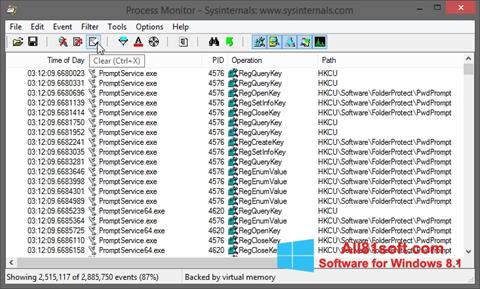

When prompted by the UAC (User Account Control), click Yes to grant administrative privileges to the newly opened Command Prompt.


Then, type “cmd” and press Ctrl + Shift + Enter to open up an elevated Command Prompt. Press Windows key + R to open up a Run dialog box.In the methods that follow, you’ll learn of two different ways that will allow you to either Add or Remove the Maximum Processor Frequency menu inside Power Options. You can only underclock the CPU frequency, given that the maximum value is the highest allowed by your CP. With this in mind, note that you can’t use this option to overclock your CPU frequency.
#Windows process monitor windows 10#
If you’re looking for ways to manually program your maximum processor frequency, this article will show you several ways to do it directly from the Windows 10 interface – no 3rd party software needed.īut keep in mind that the max MHz that you can specify will be the highest frequency allowed for the CPU. So if you have an up-to-date version of Windows 10, you can no longer adjust the Maximum Processor Frequency, because the option is now hidden by default. Starting with Windows 10 built 1709, the power supply option “ Maximum Processor Frequency” was removed from the Power Option tab.
#Windows process monitor how to#
How to Add the Maximum Processor Frequency option? Limiting the maximum frequency might end up giving you some extra minutes before you need to plug your laptop into a power source. This procedure is also effective if you’re working with a limited laptop battery and you’re looking to increase your screen time. However, manipulating the maximum processor frequency is effective in those cases where the user notices that the processor runs too hot on the default maximum frequency and wants to take precautionary steps against hardware malfunction.
#Windows process monitor Pc#
It might actually end up affecting your PC performance by limiting the maximum frequency allowed. Keep in mind that most modern processors manage themselves and there are few advantages to be gained by changing processor-related settings from the Windows menu. Plugged in – When the computer is plugged into a power source.On Battery – When the computer is running on the battery.You will be allowed to predetermine the maximum processor frequency in two different scenarios: If you know how to do this, there are ways that will help you specify the approximate maximum frequency (in MHz) of your processor from within Windows 10. Generally, the higher the frequency, the faster the processor will be. The frequency of a processor specifies the operating frequency of the CPU core(s) – It is measured in MHz. Fortunately, Windows 10 includes a way to program the maximum processor frequency, but the option is hidden by default. Maybe you want to save energy or maybe you just found out that your CPU is running too hot when it’s tasked for demanding tasks. However, there are reasons why you’d want to limit the frequency on Windows 10. Maximum Processor Frequency in Power Options

This means that the processor is allowed to run as high as it’s capable of running. By default, the maximum processor frequency is set to 0 in all the recent Windows versions. Some users have been looking for a way to program the maximum processor frequency on their PC computer.


 0 kommentar(er)
0 kommentar(er)
